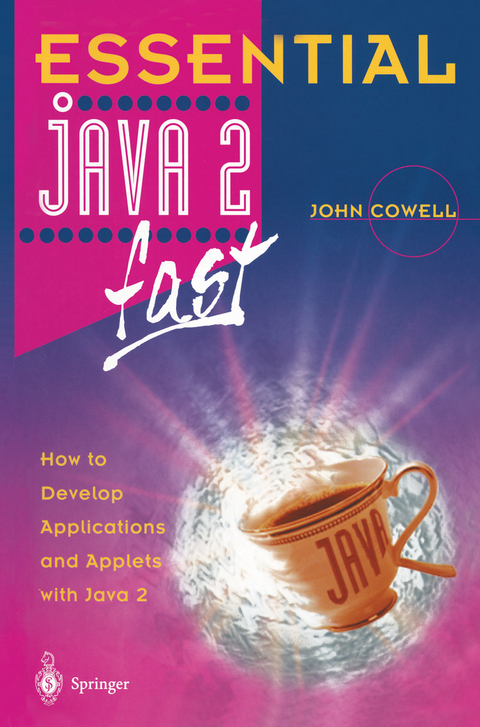
Essential Java 2 fast
Springer London Ltd (Verlag)
978-1-85233-071-2 (ISBN)
If you are a new programmer or a Java programmer moving to Java 2 then this is the book for you! It offers: a complete introduction to Java 2; describes the language and many of its class libraries; shows how they are used; describes the key concepts of object orientation with lots of examples of how to apply the theory. This book will show you how to take advantage of Java 2's new features (such as the abstract windowing toolkit and the Swing classes) for creating graphical user interfaces. John Cowell explains how to use Swing components to change the look and feel of your Java applications so that they look like Windows, Mac or Motif applications. Sun Microsystems Java 2 (formerly called the Java Development Kit 1.2 - JDK 1.2) is a major step forward in the growth of Java into a powerful mature language for writing both applications and applets. Topics covered in this book include: the Java language; the abstract windowing toolkit; the new Java Swing components; handling component, keyboard and mouse events; polymorphism and inheritance; animation and multithreading; handling exceptions; using files. Essential Java 2 - fast is designed for professional developers or students who need to learn the maximum in the minimum time. You'll develop applications and applets fast, learning everything you need to write Java applications and applets quickly with Java.
1 Why Java 2 is Special.- Is this book for you?.- What you need to run Java 2.- How to use this book.- An object-oriented approach.- Conventions.- 2 An Object-Oriented Application.- A first application.- What can go wrong?.- How does the application work?.- Classes and objects.- The main method.- What’s new.- Running the application.- Using classes and objects.- Naming conventions.- 3 The Java Language.- Applications and applets.- Comments.- Terminating Java statements.- Data types.- The integer data types.- The floating point data types.- The boolean data type.- The char data type.- The String data type.- Names in Java.- Declaring data.- Arithmetic in Java.- Mixing data types.- Casting.- Assignment operators.- Using strings in Java.- Operator precedence.- Displaying information on your screen.- 4 Branching and Looping.- The If…else statement.- Logical operators.- The switch statement.- Block statements.- Looping.- The for loop.- The while loop.- The do…while loop.- The break statement.- Arrays.- 5 Creating and Using Classes and Objects.- The Account class.- The displayDetails method.- The inCredit method.- The credit and debit methods.- The main method.- Using constructors.- Encapsulating data.- Calling methods.- Command line arguments for applications.- 6 Using Applets.- Writing applets.- The APPLET tag.- Key methods of the Applet class.- The init method.- The start method.- The stop method.- The destroy method.- The paint method.- Command line arguments for applets.- 7 The Graphics, Color and Font Classes.- The co-ordinate frame.- Importing classes.- The Graphics class.- Drawing lines.- Drawing rectangles.- Drawing circles and ovals.- Drawing arcs.- Drawing polygons.- The Color class.- Creating colours.- Displaying text and changing fonts.- Displaying images.-8 Inheritance and Polymorphism.- A hierarchy of computer components.- Defining the Memory subclass.- Polymorphism.- The MBoard class.- Extending a subclass.- Class and instance variables.- Static methods.- Overloading methods.- Access control.- Interfaces.- 9 Mouse and Keyboard Events.- The MouseEvent class.- The MouseListener interface.- Which button was pressed?.- The MouseAdapter class.- The MouseMotionListener interface.- The KeyEvent class.- The KeyAdapter class.- The KeyListener interface.- 10 The AWT Components.- Event-driven programming.- The AWT classes.- The Button class.- Handling events.- The Label class.- The Scrollbar class.- Handling Scrollbar events.- The Checkbox class.- The List class.- Multiple selection in List objects.- The TextComponent class.- The TextArea class.- Using the TextListener interface.- The TextField class.- The Canvas class.- 11 The Layout Managers.- The FlowLayout class.- The BorderLayout class.- The CardLayout class.- The GridLayout class.- The GridBagLayout class.- 12 Windows, Dialogs and Menus.- The Container class.- The Frame class.- Creating an application which uses a frame.- The WindowListener interface.- Creating an applet which uses a frame.- The MenuBar class.- The Dialog class.- The FileDialog class.- The Panel class.- 13 The Swing Components.- Differences between Swing and AWT components.- The Swing components.- The Swing container classes.- The AbstractButton class.- The Swing and AWT buttons.- Changing the look and feel.- The JButton class.- The JToggleButton, JRadioButton and JCheckBox classes.- Displaying text.- The JLabel class.- The JTextField class.- The JTextArea class.- The JList class.- The JColorChooser class.- The JFileChooser class.- 14 Java Exceptions.- The Exception class.- The try and catch clauses.- Throwing an exception.- Creating new exceptions.- Throwing without catching.- 15 Writing Threaded Applications.- Pre-emptive scheduling.- The Runnable interface.- The Thread class.- Synchronizing threads.- The Thread class.- Creating animation.- The bouncing ball applet.- 16 Files and Streams.- The File class.- The InputStream and OutputStream classes.- The DatalnputStream and DataOutputStream classes.- Using the DataOutputStream class.- Using the DatalnputStream class.- Reading text files.- Reading from the keyboard.- Converting strings to other data types.
| Erscheint lt. Verlag | 1.1.2000 |
|---|---|
| Reihe/Serie | Essential Series |
| Zusatzinfo | 73 Illustrations, black and white; X, 246 p. 73 illus. |
| Verlagsort | England |
| Sprache | englisch |
| Maße | 155 x 235 mm |
| Themenwelt | Informatik ► Programmiersprachen / -werkzeuge ► Java |
| Mathematik / Informatik ► Informatik ► Software Entwicklung | |
| Informatik ► Theorie / Studium ► Compilerbau | |
| Mathematik / Informatik ► Informatik ► Web / Internet | |
| ISBN-10 | 1-85233-071-6 / 1852330716 |
| ISBN-13 | 978-1-85233-071-2 / 9781852330712 |
| Zustand | Neuware |
| Haben Sie eine Frage zum Produkt? |
aus dem Bereich


